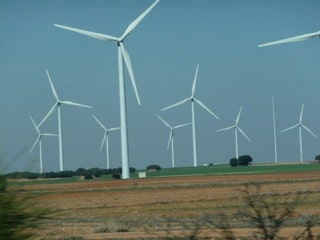ANTI–WIND farm activists around the world have created a silent bogeyman they claim can cause everything from sickness and headaches to herpes, kidney damage and cancers.
This “infrasound” exists at frequencies too low for the human ear to detect but is present almost everywhere from offices and roadsides to waves tumbling on ocean beaches. These low frequencies can crawl menacingly from the back of your kitchen fridge or from your heart beating.
Despite the ubiquitous nature of infrasound, anti-wind farm groups such as Australia’s Waubra Foundation like people to think that it’s only inaudible infrasound from wind turbines which might send residents to their sick beds.
But two new studies suggest the cause of health complaints by people living near wind farms could in fact be down to the scare campaign of the anti-wind groups and reports about such scares in the media.
The first study Can Expectations Produce Symptoms From Infrasound Associated With Wind Turbines? was published earlier this month in Health Psychology – a journal of the American Psychological Association.
The researchers from the University of Auckland in New Zealand wanted to find out if simply exposing people to warnings that turbines might make you ill was enough to cause them to report typical symptoms such as headaches and nausea.
Using 54 people, the researchers showed half the group five minutes of footage of people complaining that wind farms had made them ill. Some of the footage was taken from this Australian Broadcasting Corporation report (watch it here) into “Waubra disease” where residents were filmed complaining about a wind farm at Waubra in Victoria. Footage was also taken from this CTV Network report from Canada about a wind farm in Ontario.
This group was called the “high expectancy group” because the information they were given had led them to expect they might experience certain symptoms if exposed to infrasound. The other half of the group was shown interviews with experts stating that the science showed infrasound could not directly cause health problems.
The researchers then told each person they were going to be exposed to two 10-minute periods of infrasound in a special acoustic room when, in fact, for one of those periods they would be exposed to no sound at all, or “sham infrasound” as the researchers describe it. So what happened?
The response from the “high expectancy” group was to report that the “infrasound” had caused them to experience more symptoms which were more intense. This was the case whether they were exposed to sham infrasound or genuine infrasound. The report explains that “the number of symptoms reported and the intensity of the symptom experienced during listening sessions were not affected by exposure to infrasound but were influenced by expectancy group allocation.”
In the low expectancy group, the infrasound and sham infrasound had little to no effect. In other words, the study found that if a person is told that wind turbines will make them ill then they are likely to report symptoms, regardless of whether they are exposed to infrasound or not.
Clearly, this points the finger at anti-wind farm campaigns as a potential cause of people’s symptoms, rather than “infrasound” from turbines. The research added: “The importance of findings in this study is that symptom expectations were created by viewing TV material readily available on the Internet, indicating the potential for such expectations to be created outside of the laboratory in real-world settings.”
Writing about her research on The Conversation, lead author Fiona Crichton says
The findings indicate that negative health information readily available to people living in the vicinity of wind farms has the potential to create symptom expectations, providing a possible pathway for symptoms attributed to operating wind turbines. This may have wide-reaching implications. If symptom expectations are the root cause of symptom reporting, answering calls to increase minimum wind-farm set back distances is likely to do little to assuage health complaints.
Reading some news reports (such as those offered by The Australian newspaper’s environment editor Graham Lloyd or anti-wind activist and UK anti-wind columnist James Delingpole) and material from anti-wind farm groups, it might seem that health complaints are common among people living near turbines.
But an as yet unpublished study (and therefore not peer-reviewed) just released by Simon Chapman, the Professor of Public Health at the University of Sydney, suggests only a tiny proportion of people living near turbines do actually complain and, when they do, the complaints coincide with campaigning from anti-wind groups.
Chapman looked at health complaints made by residents living within 5 kilometres of all 49 wind farms operating in Australia between 1993 and 2012. After reviewing media reports, public inquiries and complaints to wind companies themselves, Chapman found evidence of only 120 individuals having actually complained – representing about 1 in 272 people living near wind farms.
But significantly, Chapman found that 81 of those 120 residents were living beside just five wind farms “which have been heavily targeted by anti wind farm groups”. What’s more, some 82 per cent of all the complaints had occured since 2009 when Chapman says anti-wind farm groups began to push the health scare as part of their opposition to turbines.
Some 31 of the 49 wind farms studied had never been subjected to a complaint either about noise or health.
“The 31 farms with no histories of complaints, and which today have some 21,530 residents within 5km of their turbines have operated for a cumulative total of 256 years,” says Chapman’s report. In Chapman’s research, he says that anxiety among residents increases as media reports spread the stories of health concerns and as researchers start investigating.
One down side to this research is, of course, that it tells anti-wind farm groups that by concentrating on unproven health concerns, their campaigns can illicit a steady flow of complaints and negative sentiment from communities.
Subscribe to our newsletter
Stay up to date with DeSmog news and alerts







